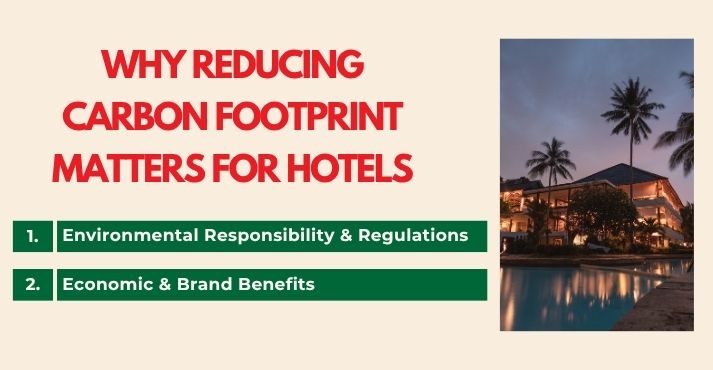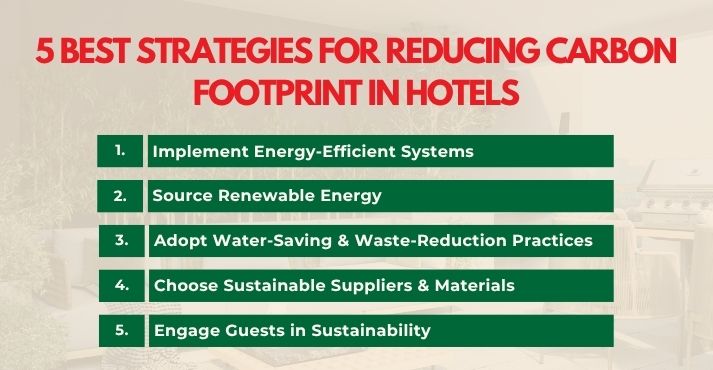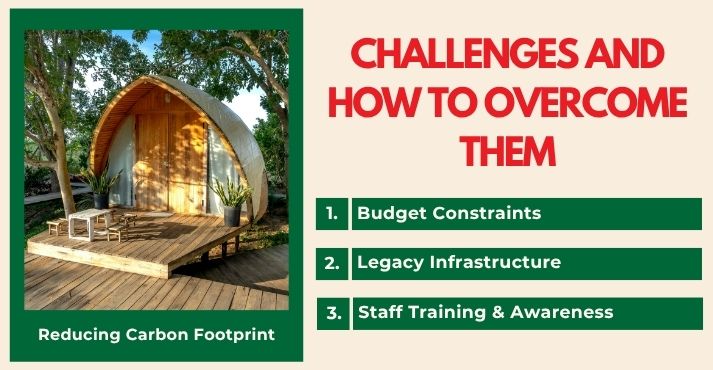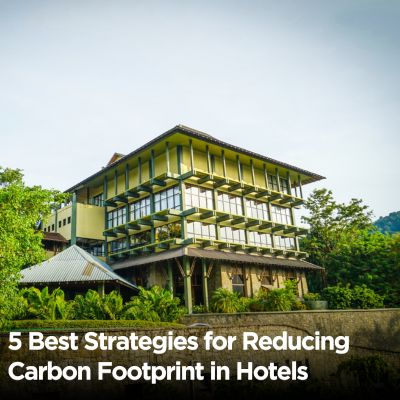Hotels use a lot of energy every day. Between heating and cooling rooms, lighting hallways, running laundry machines, and preparing food, it all adds up.
This daily activity makes hotels a major source of carbon emissions. As climate concerns grow, the hospitality industry is facing increased pressure to reduce its environmental impact.
Becoming more sustainable is no longer just a nice idea. It is something hotels need to do, both to comply with new regulations and to meet the expectations of their guests.
Travelers are becoming more aware of their choices, and many prefer to stay at places that care about the planet. According to a 2024 Booking.com report, 83% of global travelers consider sustainable travel important, and 75% plan to travel more sustainably this year.
This blog examines five of the best strategies for reducing carbon footprint in hotels, focusing on what truly helps both the environment and day-to-day hotel operations.
Why Reducing Carbon Footprint Matters for Hotels

Hotels use a large amount of energy and resources every day. Rooms require heating or cooling, lights remain on for extended periods, and laundry and food services operate continuously.
These everyday operations result in high energy consumption and significant waste. As a result, hotels contribute heavily to carbon emissions.
Taking action to reduce this impact is no longer optional. It is becoming an important part of how hotels meet guest expectations, comply with local laws, and operate more efficiently.
Environmental Responsibility and Regulations
Hotels contribute to emissions in several ways. Heating, cooling, and lighting use a lot of energy, especially in large buildings.
Daily operations like laundry, cleaning, and food service also add to the total. All of this affects the environment and prompts hotels to make more informed choices.
In many parts of the world, sustainability rules are becoming stricter. Some countries offer tax incentives for eco-friendly upgrades, while others require reporting on energy use or waste.
Green certification programs, such as LEED and Green Key, help hotels measure and improve their environmental impact. These programs are not only useful for following the law, but they also help guests identify responsible businesses.
Travelers now seek hotels that prioritize the planet, and many check for these labels before making a booking. That is why sustainable hotel operations are becoming a standard part of doing business.
Economic and Brand Benefits
Reducing energy, water, and waste not only helps the planet but also cuts costs over time. Efficient systems mean lower utility bills and longer equipment lifespans. Carbon reduction for hotels often leads to financial savings through operational efficiency.
Being known as an eco-friendly hotel can also boost your brand. Many guests appreciate sustainable hotel operations and are willing to pay more or stay loyal.
A 2024 global survey found that 85.6% of travelers stated they would be willing to pay more for an eco-friendly hotel stay.
Another study found that a few guests were open to paying a small premium of up to 5% to stay at a boutique property with environmental certification.
Letting guests know your hotel cares about sustainability can help attract them and build loyalty. Today, showing your commitment to eco-friendly hotels can help your brand stand out and attract more guests.
5 Best Strategies for Reducing Carbon Footprint in Hotels

The strategies below cover energy, water, waste, sourcing, and guest engagement. Each one helps hotels operate more sustainably and efficiently:
1. Implement Energy‑Efficient Systems
Energy use is one of the largest sources of emissions in the hotel industry, so addressing it has a significant impact. Switching to LED lighting, smart HVAC systems, motion sensors, and energy-efficient appliances can significantly reduce electricity use.
In guest rooms, hotel automation, such as occupancy sensors and smart thermostats, makes heating, cooling, and lighting more responsive to actual usage.
An example of this is the Crowne Plaza Copenhagen Towers in Denmark, which runs entirely on renewable energy and uses advanced lighting controls. It is the country’s first carbon-neutral hotel, using up to 65% less energy through these systems.
Technology leader Hotel Verde in Cape Town uses energy‑recovery ventilation to cut HVAC energy by roughly 50%, while geothermal heat pumps reduce water‑heating energy by another 40%.
2. Source Renewable Energy
Using renewable energy helps hotels cut their reliance on fossil fuels while supporting long-term sustainability goals. Some properties generate clean energy on-site through systems like solar panels or geothermal units.
Others purchase certified green energy from utility providers. In many regions, financial incentives such as tax credits or rebates help reduce the upfront investment.
An example of this is the Dunsilly Hotel in Northern Ireland, which installed a 78 kW solar PV system. It now generates over 55,000 kWh of electricity per year, pays for itself in under 3.5 years, and reduces carbon emissions by an amount equal to planting 2,700 trees.
Another example is the Svart Hotel in Norway, which was designed to be energy-positive. It uses rooftop solar panels and geothermal systems to reduce its energy use by 85% compared to similar properties.
3. Adopt Water‑Saving and Waste‑Reduction Practices
Water and waste also affect emissions. Installing low-flow showers, dual-flush toilets, and greywater systems helps conserve water.
Hotels can reduce food waste by implementing better inventory control, composting, and waste-tracking tools. Offering refillable water stations and phasing out single‑use plastics are effective ways to reduce emissions and waste.
India’s Oberoi Hotels plan to recycle 100% of wastewater by 2030, cutting fresh‑water use per occupied room by 20%. Composting and accurate waste tracking can cut landfill contributions and emissions from food waste decomposition and waste transport.
4. Choose Sustainable Suppliers and Materials
Sustainability begins long before guests arrive. Working with local suppliers and certified producers helps reduce emissions linked to transportation and large-scale manufacturing.
Choosing biodegradable amenities, low-impact construction materials, and reusable in-room items also supports long-term environmental goals. Programs like linen and towel reuse further reduce energy and water consumption.
Checklist for green suppliers:
- Local or certified eco-providers.
- Products with minimal or biodegradable packaging.
- Amenities made from renewable or reusable materials.
- Furniture and materials with low-VOC and recycled content.
These choices support efforts to reduce emissions in hospitality and show a focus on environmental sustainability in hotels. When sourcing is planned carefully, hotels can reduce their environmental impact and meet the expectations for responsible operations.
5. Engage Guests in Sustainability
Guests have a direct impact on energy and water use. Encourage them to participate through visible signs, in‑room tablets, or reminders during check‑in.
Simple options, such as offering to opt out of daily linen changes, providing recycling bins in rooms, or inviting them to join carbon-offset programs, can make a significant difference.
These eco‑friendly hotel practices help guests feel part of the effort. Boutique hotels like El Blok in Puerto Rico highlight their sustainable building features and recharge stations for reusable water bottles, which earns praise from conscious travelers.
By tapping into guest participation, hotels not only reduce emissions but also build goodwill and a stronger connection with their visitors.
Measuring and Reporting Your Hotel’s Carbon Impact
To reduce its carbon impact, a hotel should first track its energy usage. This involves monitoring the consumption of energy, water, and materials, as well as the type of waste being generated.
Tools like Energy Star Portfolio Manager help hotels measure their energy use and compare it to that of similar properties. It’s widely used across the US and helps spot where improvements can be made.
Another option is the Greenview Portal, which was made for the hotel industry. It provides a clear view of how different locations are performing, making it easier to track progress over time.
Setting a clear target, like cutting emissions by 30% by 2030, gives the team something to work toward. Many hotels already share updates in yearly reports. These reports often cover energy savings, waste reduction, and on-site changes.
They’re a helpful way to keep staff and management on the same page and show guests that sustainability is being taken seriously.
Some properties take it a step further by displaying results on digital screens in the lobby or behind the front desk. These displays might show how much electricity was saved that month or how much water was conserved compared to last year. For guests and staff, it’s a simple way to see that small actions add up.
This kind of effort isn’t limited to luxury hotels. Different types of hotels, from large chains to boutique hotels, are finding ways to track their progress. Many are becoming intelligent hotels by using data to improve daily decisions.
Tracking results supports real hotel energy-saving strategies and green building practices for hotels that lead to long-term efficiency and lower impact.
Challenges and How to Overcome Them

Pursuing sustainability in hotels comes with real-world challenges. These often involve costs, building limitations, or staff readiness. Below are some of the most common hurdles and how hotels can respond:
1. Budget Constraints
Sustainable upgrades often require upfront investment, which can be difficult for hotels with limited resources. Energy-efficient equipment, building retrofits, and new systems can add up quickly.
- Solution: Start small. Focus on low-cost changes like installing LED lights or setting up a towel reuse program. Begin with one floor or section of the hotel to test solutions before scaling up. Many regions also offer financial support in the form of green grants, rebates, or low-interest loans for projects that save energy or water.
2. Legacy Infrastructure
Older buildings may not be able to support newer systems, such as smart thermostats or solar panels, without undergoing major renovations. Structural limitations can also impact ventilation, insulation, and other efficiency measures.
- Solution: Work around existing systems where possible. For example, portable energy-monitoring tools or room-specific automation can reduce waste without full-scale changes. Consulting firms that specialize in green retrofits can help identify what’s feasible for older properties.
3. Staff Training and Awareness
Even with the right equipment, sustainability goals can fall short if staff aren’t trained or motivated to follow best practices. Misuse of systems, improper waste sorting, or inconsistent maintenance can undo the progress made.
- Solution: Invest in clear, ongoing staff training. Use signage, workshops, and team goals to keep everyone involved. When staff understand how their actions help reduce emissions in hospitality, it becomes easier to build long-term habits.
Conclusion
Reducing a hotel’s carbon footprint is not only good for the planet, but also makes sense for long-term business performance. Lower energy bills, fewer waste-related costs, and stronger guest satisfaction are just some of the benefits.
The five strategies discussed, including improving energy use, sourcing renewable power, reducing waste, selecting more sustainable materials, and engaging with guests, can lead to meaningful results.
Hotels can begin with one goal, focus on what’s manageable, and track improvements over time. It doesn’t need to happen all at once. Each small action supports larger progress.
This is an opportunity for hotel leaders to take responsibility, implement lasting changes, and guide their operations toward a more efficient, reliable, and environmentally responsible future.













